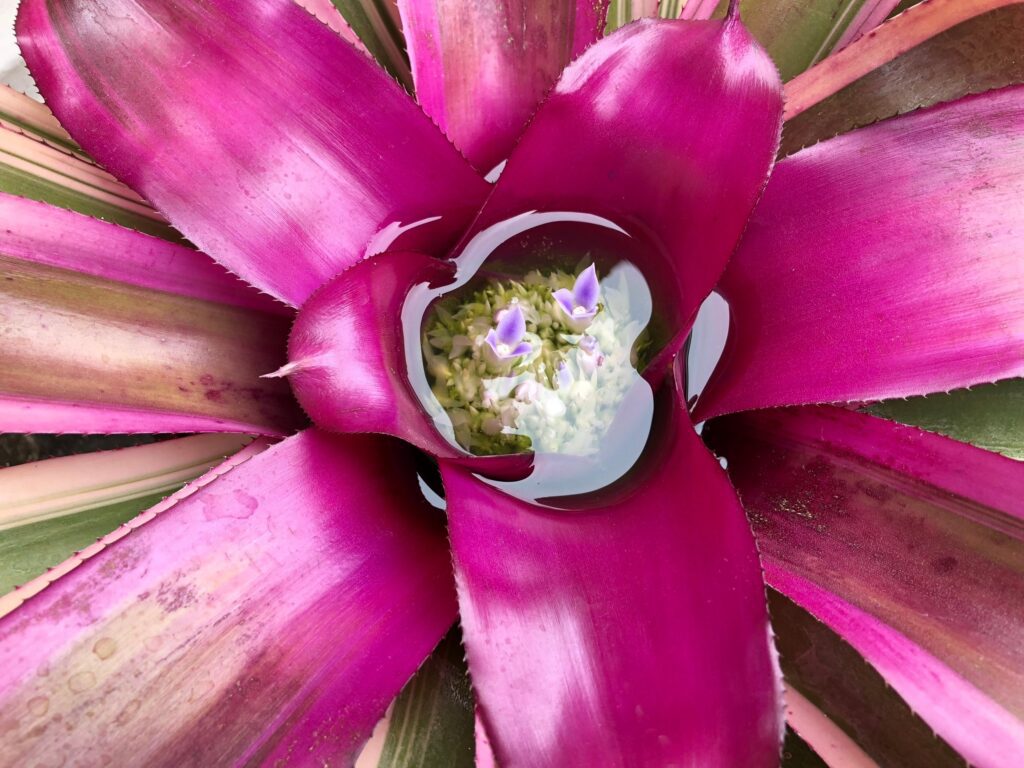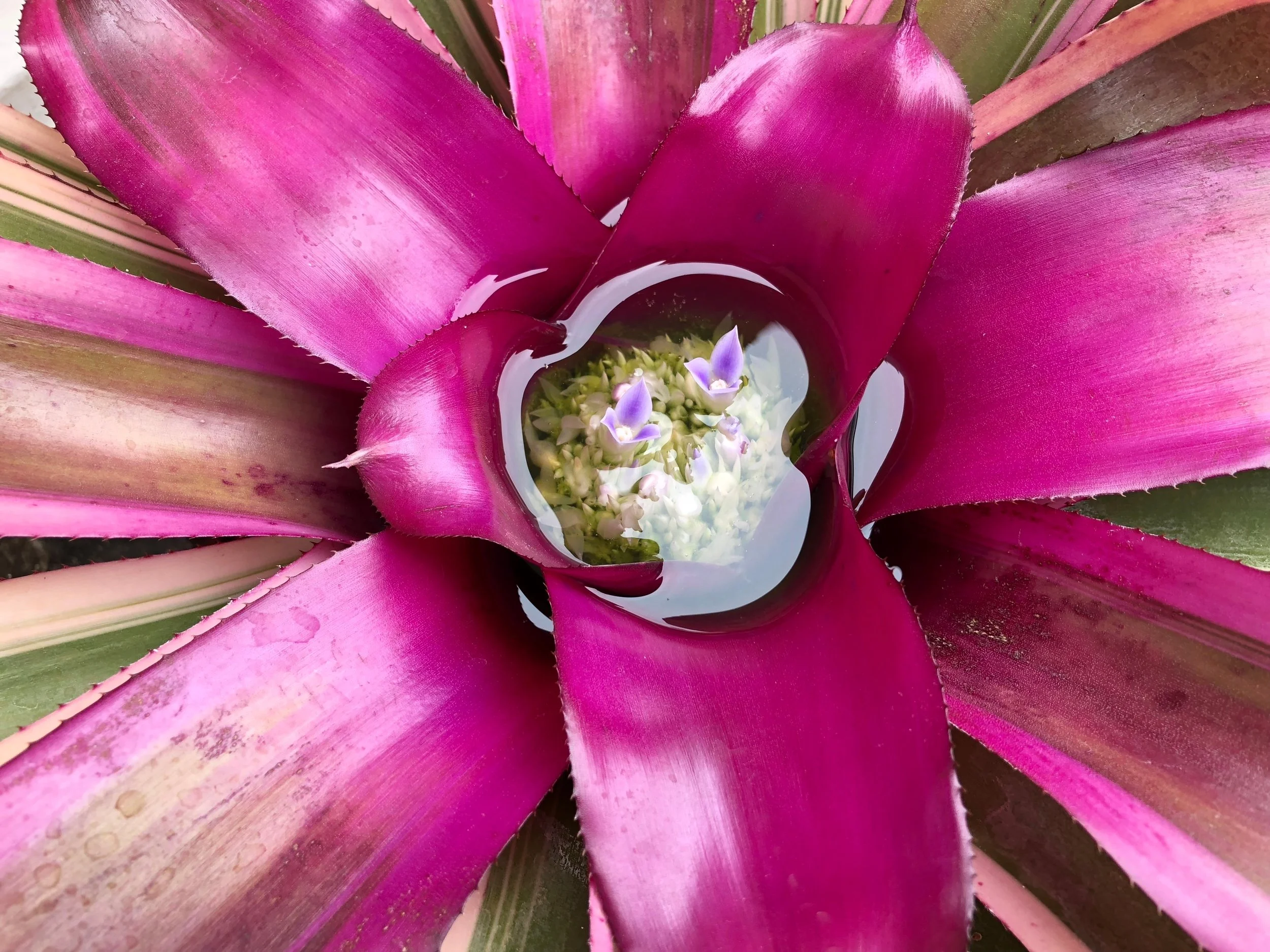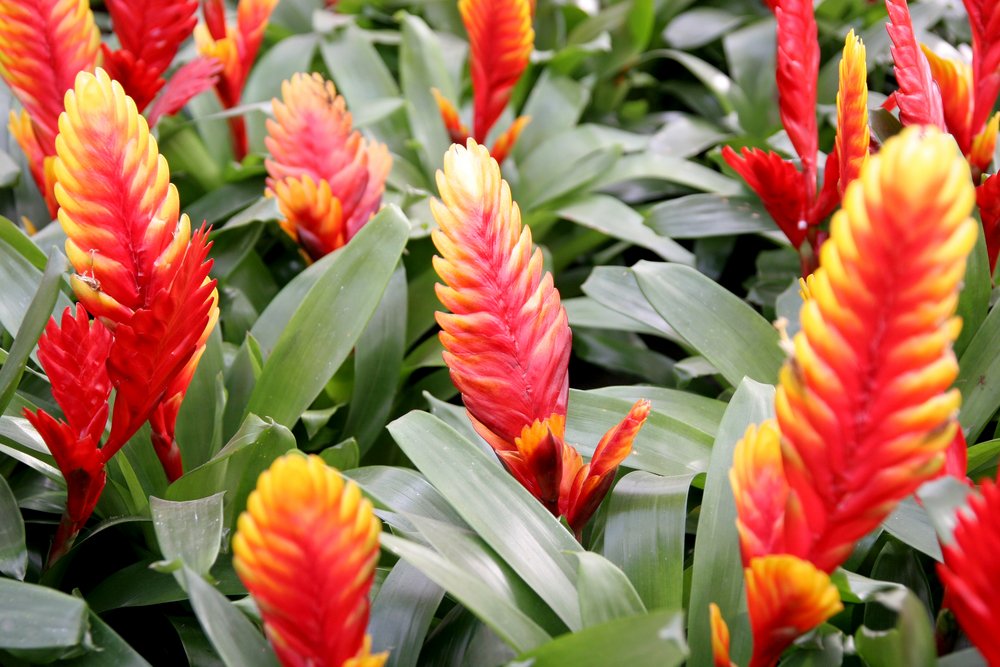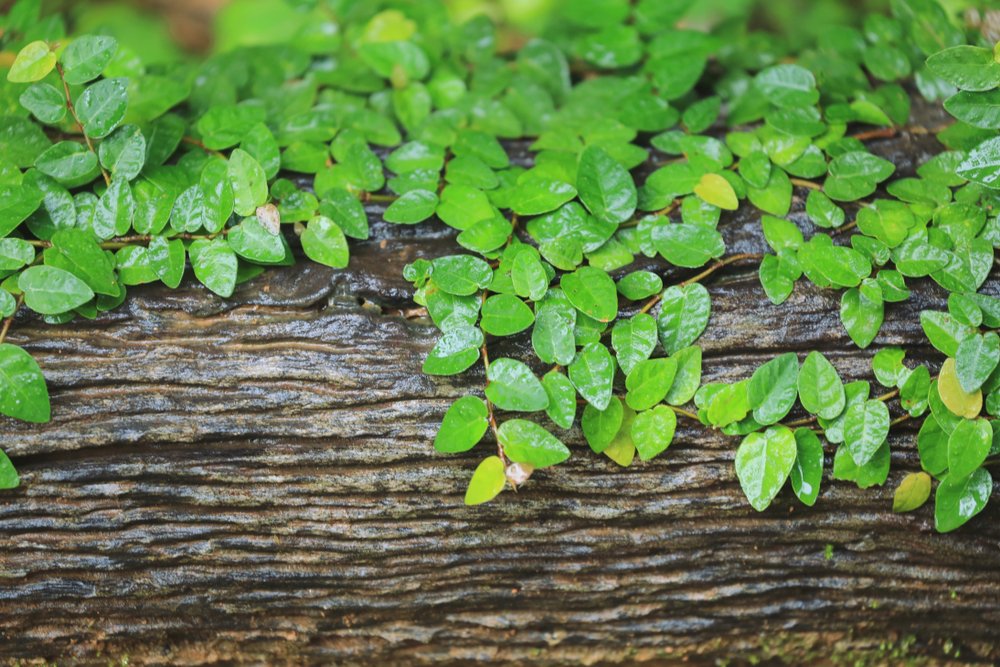Bioactive enclosures are now commonplace in the hobby and the popularity of these setups is unlikely to waver any time soon. Whilst it’s easy to take for granted the incredible products that help plants thrive, selecting the correct flora and planting it in the appropriate position can still be tricky. Horticulture is a vast discipline in and of itself and thus, marrying up the perfect combination of plants and animals can require a bit of trial and error. However, the following list provides some suggestions for the most popular and readily available plants to meet the needs of most hobbyists embarking on their new planted terrarium project.
Canopy
The canopy is often a miss-match of creeping plants that have reached the top of the terrarium but is most famously associated with epiphytes such as bromeliads. These are excellent at increasing the humidity in an enclosure and play a vital role in providing pockets of water for poison frogs to deposit tadpoles. ‘Bromeliads’ are one of the largest groups of plants on planet earth, so their ecological niches vary massively. Some of the broader-leaved varieties provide vital shelter for a range of species, such as small lizards, frogs and invertebrates. In tropical climates, these plants play host to entire ecosystems within their leaves with semi-aquatic, arboreal and terrestrial fauna colonising the ephemeral pools of water.
Bromeliads are epiphytic plants that will grow on hardscape. This is an adaptation that allows them to secure themselves to the highest tree branches to absorb as much light as possible and so should be provided with a lot of light. Many species (such as the popular Neoregelia varieties) will even ‘blush’ turning them bright pink when they receive enough sunlight. They hold a good amount of water, and some will quickly spout new growth in the form of shoots that come off the original plant and open over time.
Most bromeliads should be wrapped in moss around the base and attached to coarse décor with fishing wire, moss balls, cable ties, etc. Providing they always have a central reservoir of water; they should grow without problems. The most popular varieties are the Flaming sword (Vrisea splendens) which has an impressive red flower stemming from the centre and Guzmania which is equally as colourful. They can be utilised to bring some impressive colouration to a vivarium set up.
There are also some terrestrial bromeliads such as Cryptanthus. These can be planted into constantly moist soil, with most species flourishing in relatively low light conditions. This makes them an excellent addition to the terrarium floor.
Airplants are a type of bromeliad that tolerates much drier conditions. They generally inhabit semi-tropical areas which get a good amount of morning-dew but very little rainfall throughout the dry seasons. Each species is slightly different, with some Mexican varieties tolerating very dry conditions. All should be lightly misted in the morning, as these plants receive their moisture through their leaves, but should be mounted within the vivarium like their tropical cousins. A bit of research is recommended, to ensure you are providing optimal care or have selected the most appropriate epiphyte for the enclosure. Although many bromeliads are hardy, some (often the most expensive ones) will soon die in the wrong conditions.
Creepers and ground cover
Creepers and ground cover produce an entire sheet of vegetation that is useful for a whole spectrum of species. Smaller species will undoubtedly shelter amongst ground cover, giving them added security during times of rest. However, larger species will gain some environmental enrichment as they move through the low-lying plants whilst traversing the enclosure. These plants are often fast-growing, which is excellent for establishing a new terrarium. However, it also means maintenance is a key consideration for new keepers.
There is a whole wealth of plants that grow up surfaces to cover the backgrounds and décor of a planted set up. Ficus pumila (Creeping fig) is a shrubby plant with woody stems. It is a low growing shrub that provides excellent coverage for smaller tank mates. It will also climb upwards towards epiphytes and ferns attached higher in the terrarium, to form a full blanket of leaves. Variegated forms are also available.
Mind your own business (Soleirolia soleirolii) is an invasive and fast-growing plant. It is extremely popular and widely used for rapid ground cover as it creates a lawn-like backdrop extremely quickly. Although this species is easily controlled by simply pulling sections out of the enclosure, it is very difficult to eradicate once it’s established.
Ferns
Ferns generally thrive in much lower light conditions than many other tropical plants. This makes them brilliant for filling the bottom levels of a terrarium where light may be limited. Historically, they have been used in a variety of terrariums but are most closely associated with the geckos of New Caledonia (Correlophus sp. & Rhacodactylus sp.). They are abundant in semi-tropical or montane forests with thick canopies and make excellent shelter for animals to hide behind. Due to their fragile nature, they are not easily perched upon which can prevent the inhabitants from damaging the plant.
Korean rock fern (Polystichum tsus-simense) is a popular, low growing fern that can create excellent cover for terrestrial animals. Coming from Japan, it is tolerant of reasonably cool temperatures and would even survive outdoor temperatures here in the UK.
Selaginella is also extremely popular, despite it not being a true fern. Its popularity is largely due to the fact it can create the mossy carpet look that many keepers are trying to achieve. It is tolerant of very low light conditions and moist substrate, making it great for the base of a terrarium.
It should also be noted that a few stick insect species specialise in eating ferns. Invert enthusiasts may benefit from keeping some of these handy, especially if they are grown in other set ups within a collection.
Climbers
Climbers offer a third dimension to a planted terrarium. Broad-leaved varieties offer a place of refuge for frogs or small species such as Anolis sp. They provide sturdy climbing opportunities as well as egg-laying areas for different geckos and therefore could be considered essential in maximising the useable space in an enclosure. As well as the more practical broad-leaved climbers, Marcgravia .sp offer some visually stunning cover and assist in making a display terrarium look ‘natural’. Other climbers sit somewhere in the middle and often ‘ground-cover’ plants will still colonise the walls of a terrarium too.
Philodendrons are possibly the most common ‘climber’ and these are found all over the tropics. There are hundreds of species which vary massively. Some are huge monsters that can climb the trunks of 100m tall trees while others are well behaved and much lower growing. Naturally, we see more of the latter in the hobby. Philodendrons generally have broad leaves and make good climbing and resting opportunities for small tree frogs and geckos. Philodendrons will climb round branches and throw out airing roots to absorb moisture from the air and will eventually grow to a point where their ground roots are no longer needed. Therefore, we should be planting our Philodendrons in the ground as small plants but expect them to colonise branches later on.
Waxplants (Hoya spp.) fill a similar ecological niche to Philodendrons but are more adapted to a drier terrarium. Waxplants should not be constantly wet but are considered tropical and will thrive in high humidity environments. Like Philodendrons, they clamber around other plants. A great way to install these plants is to simply attach the pot to the terrarium wall with aquarium-safe silicon and then hide the pot with cork or to place the pot within a cork tube and attach that to the terrarium wall. Wax plants are extremely popular as garden or veranda plants in tropical regions due to their spectacular flower clusters which drip nectar and are very fragrant. This is naturally beneficial to many species and provides some good enrichment whilst also being visually appealing. Some species may also tolerate very dry conditions, but customers are urged to research the exact variety before planting.
Arid
There are a lot of arid plants available in the hobby today that are not utilised as commonly as tropical plants. They can make spectacular set ups that are visually stunning, practical and appear extremely natural. Arid plants, like their tropical cousins, can help increase humidity in select areas across the enclosure called ‘micro-climates’.
Sansevieria, or Mother-in-laws tongue, is one of the more popular of these plants. Like many arid plants, it stores moisture in its leaves which results in them becoming thick and fleshy. These leaves are excellent refuge places for small terrestrial geckos which will hide between the leaves. They should be carefully positioned to allow the animal to do this as they please.
Aloes and echeverias are ground plants that form rosettes. Just like Sansevieria sp., they form fleshy leaves which retain moisture. Planting several of these low-level plants beside one another can create an extremely natural enclosure that looks spectacular. Other more visually appealing species include the ‘pebble plants’ such as Lithops which provides some interesting natural-looking flora. These are extremely sturdy and will tolerate explorative snakes moving across the environment.
Some keepers may struggle with arid plants, simply because most require a more complex watering method than many tropical plants. In an arid bioactive set up, the keeper should aim to fill the drainage layer with water, allowing the plants’ roots to grow down naturally. Then, only light misting is required above the surface to simulate morning dew and meet the animals’ necessary humidity requirements. Often, novice keepers will water an arid plant from above which not only causes the moisture to be held on the top layer without reaching the roots but too much liquid on the surface of a plant will cause many arid species to rot. Watering too much, to ensure the moisture falls towards the drainage layer will also disperse the substrate too much. Therefore, careful consideration is needed when establishing an arid bio-active or naturally planted setup.
Other considerations
The possibilities are endless when it comes to selecting flora for an enclosure. With such a vast spectrum of species now readily available, even geographically sound biotopes are possible to create with the correct research. It is a good idea to ask zookeepers and private hobbyists what species of plants they are using in their exhibits, to avoid an overwhelming amount of trial and error (the keeper or breeder has probably already done this hard work!) There are a number of species that are available in the hobby that are some keepers’ “bread and butter”.
Pothos is extremely popular amongst tree frog breeders. In the US, they are some of the most common species of plant in bioactive set ups, meaning novice customers will likely be aware of the plants already. Their broad leaves are excellent for tree frogs, they grow quickly, and they are extremely hardy. A hanging pot of Pothos over a pond of water is usually the plant of choice for breeders of frogs who lay clutches or foam nests in leaves overhanging seasonal pools. These plants can be utilised from a hanging position, planted into a pot in the background, or even just grow straight out of water (making them ideal for paludariums too).
Other plants which can be planted high in the terrarium to hang down include the Maidenhair Vine (Muehlenbeckia complexa) which has thin stems which snake over the ground and climb up walls and décor. It needs high humidity and constantly moist soil but must not be waterlogged. This species can cover entire walls in ornamental garden features, so the keeper should be prepared for frequent maintenance.
The flamingo flower (Anthurium) is a very popular house plant because of its vibrant red flowers. It can be grown indoors and later planted into an enclosure, making it extremely versatile and an ideal suggestion for a gift. Coming from tropical regions, the terrarium setting is ideal for this species. It grows upright leaves making it an ideal background plant and will add some excellent colour to the vivarium.
Begonias are also a huge group of tropical and subtropical plants consisting of over 2000 species. Polka dot begonia (Begonia maculata) are very popular. They have broad leaves which, as the name suggests, are dotted with white markings making them very visually striking. They come from South Brazil and require careful watering, with evenly moist soil. Their large leaves and sturdy upright growth make them perfect for frogs or small geckos.
Getting it right
Horticulture is an entirely disparate discipline to herpetoculture and one which requires lots of knowledge to become an expert in. This means that most reptile and amphibian enthusiasts will be required to experiment broadly with different plant species to see what works. Even house plants can provide a challenge for the inexperienced, so the addition of artificial lighting, décor, backgrounds and fauna will undoubtedly present new challenges. There are many apps available online to ID plant species, as well as ‘plant passports’ used within the industry (which are actually a legal requirement when imported from abroad) that should contain some details on caring for the species. However, the best advice is usually from other hobbyists or the store which you are purchasing the plant from. Not every plant will instantly flourish, but the ones discussed in this feature are some of the hardiest available. Although, variety is the spice of life and experimenting with new plants is a fun way to keep things interesting. Oh, and if it doesn’t turn out as expected, leaf litter makes for a wonderful enrichment opportunity!
If you liked this article, sign up to the magazine for FREE here.










